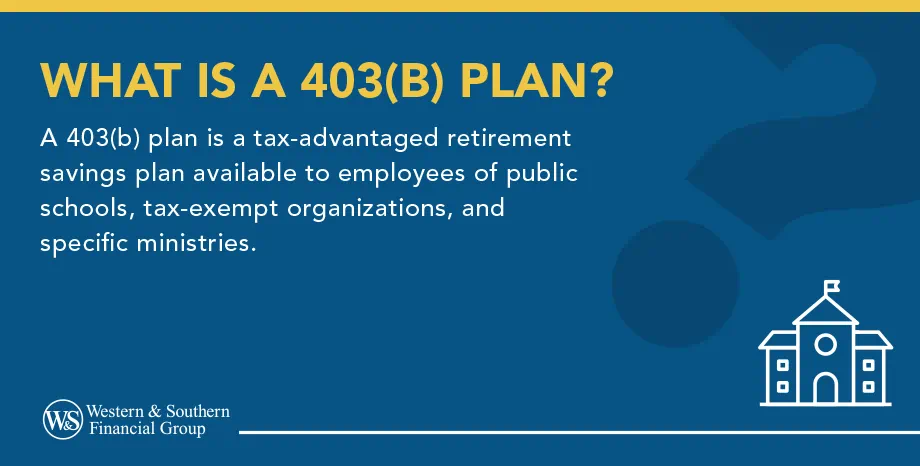

Key Takeaways
- 403(b) plans offer tax-advantaged retirement savings for public school and 501(c)(3) nonprofit employees.
- Contributions can be pre-tax (reducing current income) or after-tax (Roth tax-free withdrawals in retirement).
- Employer matching contributions can significantly boost savings.
- Catch-up contributions are available for those 50+ and, in some cases, those with 15+ years of service.
- Financial options vary, but often include mutual funds, index funds, and annuities.
What Is a 403(b) Plan?
A 403(b) is a retirement savings plan designed specifically for employees of public schools, certain nonprofit organizations, and some ministries. It’s often compared to the better-known 401(k), but the 403(b) comes with unique features that cater to the needs of teachers, administrators, nurses in nonprofit hospitals, and other eligible participants.
A 403(b) offers tax-deferred growth, allowing individuals to potentially build retirement savings over time.
Key Features of 403(b) Plans:
- Tax Advantages: Contributions are typically made pre-tax, lowering your annual taxable income.
- Potential Employer Matching: Some organizations offer matching contributions, free money that can dramatically boost your retirement savings.
- Early Withdrawal Exceptions: Public school employees can sometimes withdraw funds without penalty if they separate from service in or after the year they turn 55.
- Catch-Up Contributions: If you’re 50 or older, you can contribute more than the standard limit, accelerating your savings in the crucial years before retirement.
Who Qualifies for a 403(b)?
You can participate in a 403(b) plan if you work for:
- A public school (K-12, college, university).
- A 501(c)(3) tax-exempt organization (charities, religious organizations, private universities, etc.).
- Public hospitals and healthcare facilities
- Certain ministers.
The key is your employer's tax status, not your job title. Government employees (except for public school employees) and employees of for-profit businesses are not eligible.
How Does a 403(b) Work?
The 403(b) was introduced in 1958 as an option for nonprofit and educational employees to set aside money for retirement without immediate taxation.
Historically, these employees earned lower salaries compared to their corporate counterparts, so the 403(b) was intended to level the playing field by offering a tax break and a chance to accumulate savings more effectively.
Over the years, the types of 403(b) plans have evolved. Participants can choose between traditional (pre-tax) contributions or Roth (after-tax) contributions, allowing individuals to tailor contributions based on current tax needs or future tax projections.
- Traditional 403(b): Contributions are made pre-tax, reducing your current taxable income. Withdrawals in retirement are taxed as ordinary income.
- Roth 403(b): Some plans offer this option where contributions are made after-tax, but qualified withdrawals in retirement are completely tax-free.
403b Contribution Limits
For 2025 (and beyond, subject to annual adjustments by the IRS), you can typically contribute up to a set dollar limit. Annual contribution of $23,500 for those under 50, and an additional $7,500 in catch-up contributions for those 50 or older.
Catch-Up Provision for Long-Term Employees
Some 403(b) plans offer a 15-year rule in some very specific cases. Employees with at least 15 years of service with the same qualifying employer may be eligible for an additional catch-up contribution. The provision enables certain long-term employees to contribute an additional $3,000 annually (up to a lifetime maximum of $15,000).
This is less common, highly dependent on the specific plan, and often requires detailed calculations. Consult with your plan administrator and a financial advisor to determine eligibility and calculate the permitted amount.
Financial Options
Initially, many 403(b) plans offered only annuity contracts, hence the “tax-sheltered annuity” nickname. You’ll often find options enabling you to build a diversified portfolio that can be adjusted to your risk tolerance, financial goals, and time horizon.
Examples of options you might see in a 403(b) lineup:
- Target-Date Funds: Ideal for a hands-off approach.
- Index Funds: Lower-cost options that track market benchmarks.
- Actively Managed Mutual Funds: Aim to outperform the market, but they often come with higher fees.
- Fixed or Variable Annuities: Provide guaranteed returns or returns tied to market performance, respectively.
Withdrawals and Distributions
Qualified Withdrawals
Generally, you can begin taking penalty-free distributions from your 403(b) at age 59½. Required Minimum Distributions (RMDs) must begin at age 73 (as of 2023 rules).
Early Withdrawals
Withdrawals before age 59½ typically incur a 10% penalty in addition to income taxes, with certain exceptions:
- Separation from service at age 55 or older
- Total and permanent disability
- Qualified medical expenses exceeding 7.5% of adjusted gross income
- Substantially equal periodic payments (SEPP/72t distributions)
- Qualified domestic relations orders (QDROs)
Loan Provisions
Many 403(b) plans allow participants to borrow from their accounts, typically up to 50% of the vested balance up to a specific limit. These loans must generally be repaid within five years.
Rollovers: Moving Your Money
You can typically roll over funds from a 403(b) to another eligible retirement plan, such as an IRA or a 401(k) (if you change jobs), without incurring taxes or penalties. This approach can provide greater investment flexibility and potentially lower fees. Always consult with a financial advisor or registered representative before initiating a rollover.
Advantages of 403(b) Plans
- Tax Benefits: Contributing to a 403(b) reduces your taxable income, potentially lowering your tax bracket. The power of tax-deferred growth means your investment earnings compound over time, creating a more significant amount of money in retirement.
- Employer Matching: Many plans offer matching employer contributions, providing free money toward your retirement.
- Higher Contribution Limits: The 403(b)'s $23,500 contribution limit far exceeds the $7,000 limit for IRAs, allowing participants to save substantially more for retirement each year.
- Additional Catch-Up Provisions: The 15-year service catch-up provision is unique to 403(b) plans, allowing qualifying long-term employees to contribute up to $3,000 extra annually (lifetime maximum of $15,000), in addition to the standard age 50+ catch-up provision.
Potential Drawbacks of 403(b) Plans
- Limited Options: Historically, many 403(b) plans offered primarily annuity products with high fees and surrender charges. While improving, some plans still have more restricted menus than their 401(k) counterparts.
- Higher Fees: Some 403(b) plans, mainly those heavily focused on annuity products, carry higher administrative and fees that can significantly erode returns over time.
- Complex Rules: Special provisions, such as the 15-year rule, complicate 403(b) plans, making it more challenging to optimize contributions without professional guidance.
- Potential Vendor Confusion: Many educational institutions offer multiple 403(b) vendors, which can potentially overwhelm the selection process for employees.
Pros & Cons of a 403(b)
| Pros | Cons |
|---|---|
| Lower taxable income due to pre-tax contributions | Investment choices may sometimes be limited depending on your employer’s plan |
| Potential for employer matching contributions | Early withdrawal before age 59½ usually incurs a 10% penalty (with some exceptions) |
| Tax-deferred growth or tax-free (Roth) growth, depending on plan provisions | Higher fees in some annuity-based 403(b) plans compared to 401(k) plans |
| Specialized options for certain nonprofit and educational employees | Not all employers offer matching or comprehensive investment education |
How to Maximize Your 403(b)
- Start Early: The power of compound interest means that early contributions have the most significant impact. Even small contributions in your 20s and 30s can grow substantially by retirement age.
- Capture All Employer Matches: Always contribute at least enough to receive your full employer match—this is essentially free money that provides an immediate return on your investment.
- Utilize Catch-Up Provisions: If you're over 50 or have 15+ years of service with a qualifying employer, take advantage of the catch-up provisions to accelerate your retirement savings.
- Diversify Your Investments: Don't put all your eggs in one basket. Create a diversified portfolio based on your risk tolerance and time horizon.
- Monitor Fees: Review your investment options and select lower-cost funds when possible. Even a 1% difference in fees can reduce your retirement balance by tens of thousands of dollars over time.
- Consider a Roth Option: If your plan offers a Roth 403(b), evaluate whether paying taxes now for tax-free growth and withdrawals later makes sense for your situation.
Common Mistakes to Avoid with 403(b) Plans
- Not Participating: The biggest mistake is not participating at all. Even small contributions can grow significantly over time.
- Neglecting to Increase Contributions: Life gets busy. However, failing to adjust your contributions as your salary rises can significantly reduce your total savings over time.
- Ignoring Fees: High-fee investment options can dramatically reduce your returns. Always understand what you're paying.
- Failing to Diversify: Putting all your retirement savings in a single investment type increases risk unnecessarily.
- Cashing Out When Changing Jobs: Taking a distribution instead of rolling over your 403(b) when changing employers can trigger taxes and penalties.
- Overlooking Catch-Up Provisions: Many eligible employees fail to take advantage of the special catch-up provisions unique to 403(b) plans.
403(b) vs. 401(k)
| Feature | 403(b) | 401(k) |
|---|---|---|
| Eligible employees | Nonprofit, public education, religious organizations | For-profit companies |
| 2025 contribution limit | Varies based on age | $23,500 |
| Age 50+ catch-up | $7,500 | $7,500 |
| Special catch-up provisions | 15-year rule ($3,000/year) | None |
| Early withdrawal penalty | 10% before age 59½ (with exceptions) | 10% before age 59½ (with exceptions) |
| Employer match | Sometimes | Common |
| Investment options | Historically limited, improving | Typically diverse |
Why 403(b) Plans Matter in Retirement Planning
A 403(b) can serve as the foundation of your retirement strategy, particularly if you work in a sector that traditionally offers lower salaries than for-profit companies. Here’s why it matters:
- Tax Savings Today (or Later):
- Traditional (Pre-Tax) Contributions: You reduce your taxable income right now, giving you extra money in your paycheck to invest or cover living expenses. When you retire, withdrawals are taxed as ordinary income.
- Roth (After-Tax) Contributions: You pay taxes on the money before contributing it to your 403(b), but all qualified withdrawals in retirement are typically tax-free.
- Strategic Blend: Some employers allow you to split contributions between pre-tax and Roth, helping you balance tax obligations now and in the future.
- Compound Growth Over Time:
- The power of compounding means your money grows exponentially, especially if you start early. Even small, regular contributions can balloon substantially by the time you retire.
- Employer Matching = Free Money:
- Many nonprofit and educational institutions match a percentage of your contributions up to a certain limit. It’s essentially free money you don’t want to leave on the table.
- Broad Selection:
- Although some 403(b) plans stick to annuities, many now offer mutual funds, index funds, target-date funds, and more. This range of options lets you diversify according to your risk tolerance, time horizon, and objectives.
- Portability:
- If you change jobs, you can often leave the funds in the existing plan, roll them into a new employer’s plan (if allowed), or roll over into an IRA. This flexibility helps you maintain control of your retirement savings as your career evolves.
Conclusion
A 403(b) plan is valuable for building a secure retirement. By understanding its features, maximizing contributions, and making informed investment choices, you can take control of your financial future.
Explore how a 403(b) can help secure your retirement. Start Your Free Plan
Frequently Asked Questions
What happens to my 403(b) if I change jobs?
If you change jobs, your 403(b) doesn't disappear; you have several options. You can leave it with your previous employer (if allowed), roll it over into an IRA or your new employer's retirement plan (if they accept rollovers), or, less commonly, cash it out (but this usually incurs taxes and penalties).
Can I withdraw from 403b while still employed?
Generally, withdrawing from a 403(b) while still employed is restricted before age 59½, except for specific hardship situations or through a loan, if your plan allows it. However, withdrawals before 59 1/2 are usually subject to a 10% penalty, and ordinary income tax, unless a specific exception applies.
Can I borrow against my 403b?
Yes, many 403(b) plans allow you to borrow against your account balance, but this depends on your specific plan's rules. There are IRS limits on loan amounts and repayment terms, and failing to repay the loan can result in taxes and penalties.
Can I withdraw from my 403(b) for a financial hardship?
Many 403(b) plans allow hardship withdrawals for immediate and heavy financial needs, such as medical expenses, home purchases, tuition, or preventing eviction. These withdrawals are subject to applicable income taxes and potentially early withdrawal penalties.
Sources
- IRC 403(b) tax-sheltered annuity plans - Internal Revenue Service (IRS). https://www.irs.gov/retirement-plans/irc-403b-tax-sheltered-annuity-plans
- Retirement plans FAQs regarding 403(b) tax-sheltered annuity plans - Internal Revenue Service (IRS). https://www.irs.gov/retirement-plans/retirement-plans-faqs-regarding-403b-tax-sheltered-annuity-plans
- Retirement topics - 403(b) contribution limits - Internal Revenue Service (IRS). https://www.irs.gov/retirement-plans/plan-participant-employee/retirement-topics-403b-contribution-limits
- Retirement topics - Exceptions to tax on early distributions- Internal Revenue Service (IRS). https://www.irs.gov/retirement-plans/plan-participant-employee/retirement-topics-exceptions-to-tax-on-early-distributions
- 403(b) Pension Plans: Overview and Legislative Developments - U.S. Congress Congressional Research Service (CRS). https://crsreports.congress.gov/product/pdf/IF/IF12518
- 401(k) limit increases to $23,500 for 2025, IRA limit remains $7,000 - Internal Revenue Service (IRS). https://www.irs.gov/newsroom/401k-limit-increases-to-23500-for-2025-ira-limit-remains-7000









